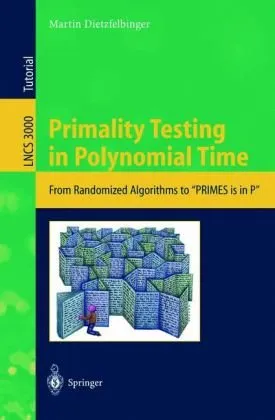Primality Testing in Polynomial Time: From Randomized Algorithms to "PRIMES Is in P"
4.6
بر اساس نظر کاربران

شما میتونید سوالاتتون در باره کتاب رو از هوش مصنوعیش بعد از ورود بپرسید
هر دانلود یا پرسش از هوش مصنوعی 2 امتیاز لازم دارد، برای بدست آوردن امتیاز رایگان، به صفحه ی راهنمای امتیازات سر بزنید و یک سری کار ارزشمند انجام بدینمقدمهای بر کتاب "Primality Testing in Polynomial Time: From Randomized Algorithms to 'PRIMES Is in P'"
کتاب "Primality Testing in Polynomial Time" اثر من، مارتین دیتسفلبینگر، یک سفر عمیق و جذاب به دنیای نظریه اعداد و الگوریتمهای محاسباتی است. این اثر، نه تنها جنبههای کلاسیک تست اول بودن (Primality Testing) را بررسی میکند، بلکه تحولات مدرن، از جمله الگوریتم تاریخی "PRIMES Is in P"، را تحلیل میکند. هدف این کتاب، ارائه مقدمهای جامع به خوانندگان درباره این مبحث پیچیده است، به طوری که مفاهیم اصلی هم برای افراد تازهوارد و هم برای محققان حرفهای به وضوح بیان شود.
خلاصه تفصیلی کتاب
کتاب شامل مباحثی است که درک عمیقی از جنبههای ریاضی و محاسباتی تست اول بودن ارائه میدهد. در ابتدا، مرور کلی بر الگوریتمهای تصادفی (Randomized Algorithms) ارائه میشود که در دهههای گذشته برای تست اول بودن پیشرفت داشتهاند. این الگوریتمها شامل Rabin-Miller و Solovay-Strassen هستند که هر دو با پیچیدگی زمانی قابلتوجه و کارایی بالا مورد استفاده قرار گرفتهاند.
با گذر به بخشهای پیشرفتهتر، داستان موفقیت الگوریتم "PRIMES Is in P" به عنوان شاهکاری در نظریه محاسبات مطرح میشود. این الگوریتم توسط Agarwal، Kayal، و Saxena در سال 2002 معرفی شد و اثبات نمود که میتوان تست اول بودن را در زمان چندجملهای کامل (Deterministic Polynomial Time) انجام داد. در اینجا، اثبات کامل ریاضی و نیز پیامدهای این نتیجه بحث میشود.
همچنین به بررسی کاربردهای عملی تست اول بودن، از جمله در رمزنگاری، طراحی الگوریتمهای ایمن، و تحلیل دادههای بزرگ پرداخته میشود. این کاربردها نشان میدهند که تست اول بودن تنها یک مسئله نظری نیست بلکه در قلب بسیاری از فناوریهای پیشرفته جای دارد.
نکات کلیدی کتاب
- تاریخچه تکامل الگوریتمهای تست اول بودن، از روشهای کلاسیک تا الگوریتمهای مدرن.
- توضیح دقیق ریاضیات و تحلیل الگوریتم "PRIMES Is in P".
- نقش الگوریتمهای تصادفی و قطعی در تست اول بودن.
- کاربردهای تست اول بودن در زمینه رمزنگاری و امنیت اطلاعات.
- اثرات پیشرفتهای اخیر در نظریه اعداد بر سایر شاخههای علوم رایانه و فناوری.
جملات معروف از کتاب
"The discovery that PRIMES is in P is more than just a computational breakthrough; it is a triumph of mathematical creativity bridging centuries of theoretical inquiry."
"Primality testing is not merely about verifying numbers; it is about unveiling the harmony between randomness and determinism in computation."
چرا این کتاب اهمیت دارد؟
تست اول بودن، یکی از مسائل کلیدی در علوم کامپیوتر نظری و ریاضیات، سالها چالشبرانگیز بوده است. با معرفی الگوریتم "PRIMES Is in P"، این مبحث وارد عصری جدید شد که امکانپذیری یافتن جوابهای سریع و قطعی برای تست اول بودن را ممکن نمود. این کتاب از این نظر اهمیت دارد که:
- بینش جامعی درباره تاریخچه و پیشرفتهای علمی ارائه میدهد.
- به زبان ساده، مفاهیم پیچیده ریاضی را برای خوانندگان بازگشایی میکند.
- الهامبخش محققان و دانشجویان برای ورود به این زمینه است.
- پیوند نظریه و کاربرد را به خوبی نمایش میدهد.
- نقش الگوریتمهای تست اول بودن در امنیت اطلاعات و فناوریهای مدرن را برجسته میکند.
Introduction to "Primality Testing in Polynomial Time: From Randomized Algorithms to 'PRIMES Is in P'"
The study and exploration of prime numbers have long held a central position in mathematics, their enigmatic nature challenging both amateurs and experts alike. "Primality Testing in Polynomial Time" delves deeply into the nuanced world of prime number testing, presenting a compelling journey from the early days of randomized primality-testing algorithms to the groundbreaking discovery that "PRIMES is in P". This book provides a detailed and interconnected narrative that is both an academic exploration and an authoritative resource for computer scientists, mathematicians, and students captivated by computational number theory.
The question of whether a given number is prime is not only a fascinating theoretical problem but also a cornerstone of modern cryptography and computer science. This book gives readers not only the mathematical frameworks but also the historical and computational contexts to fully grasp the development of primality testing into its current efficient and deterministic form. Richly detailed yet accessible, this book serves both as a reference and an educational tool, balancing clarity with mathematical rigor to ensure readers with varied levels of expertise can engage with its subject matter.
Detailed Summary of the Book
"Primality Testing in Polynomial Time" is organized to cater to both newcomers and advanced readers interested in computational mathematics. The text begins with the historical significance of prime numbers, delving into their applications and the earliest attempts at testing primality. It presents an extensive discussion on the early randomized algorithms, such as the Solovay-Strassen, Miller-Rabin, and earlier deterministic approaches like trial division.
The book's major focus converges on the celebrated AKS primality test, developed by Agrawal, Kayal, and Saxena in 2002. The AKS algorithm was the first to conclusively prove that primality testing could be performed in deterministic polynomial time — an achievement encapsulated in the claim that "PRIMES is in P". Through careful and stepwise exposition, the book explores the mathematical insights, computational principles, and proofs underpinning the AKS algorithm.
Moreover, the book highlights the practical implications of these findings in areas like cryptographic security and computational efficiency. It examines related techniques and their implementation, inviting readers to understand how the theoretical breakthroughs translate into real-world applications, such as secure communication and cryptographic protocols.
Key Takeaways
- An in-depth understanding of the journey from randomized to deterministic algorithms in primality testing.
- Detailed exploration and proof of the AKS primality test, demonstrating that "PRIMES is in P".
- A broader context linking algorithm design to cryptographic applications.
- Insights into the mathematical and theoretical frameworks that paved the way for subsequent algorithmic advances.
- A balanced approach catering to readers with varying familiarity with computational number theory.
Famous Quotes from the Book
"Prime numbers are the heartbeat of mathematics, their unyielding regularity charting the course of centuries of intellectual curiosity."
"To determine primality is not merely a mathematical exercise; it is a testament to the power of computational ingenuity."
Why This Book Matters
The discovery that "PRIMES is in P" was a groundbreaking milestone that profoundly impacted computational mathematics and theoretical computer science. It revolutionized how we understand questions of primality and efficiency, building a bridge between pure mathematical theory and real-world computational applications. This book is more than an academic treatise — it is a chronicle of one of the finest achievements in the history of algorithms, demonstrating how an age-old problem inspired a new era of discovery.
The themes explored in this book resonate far beyond the realm of primality testing. They underscore the ingenuity of mathematical minds and the persistence required to transform an idea into a definitive proof. By presenting these breakthroughs in an accessible and structured manner, the book ensures that this knowledge is not confined to a privileged few but shared with a broader audience, fueling curiosity and inspiration for future discoveries.
دانلود رایگان مستقیم
برای دانلود رایگان این کتاب و هزاران کتاب دیگه همین حالا عضو بشین
برای خواندن این کتاب باید نرم افزار PDF Reader را دانلود کنید Foxit Reader


